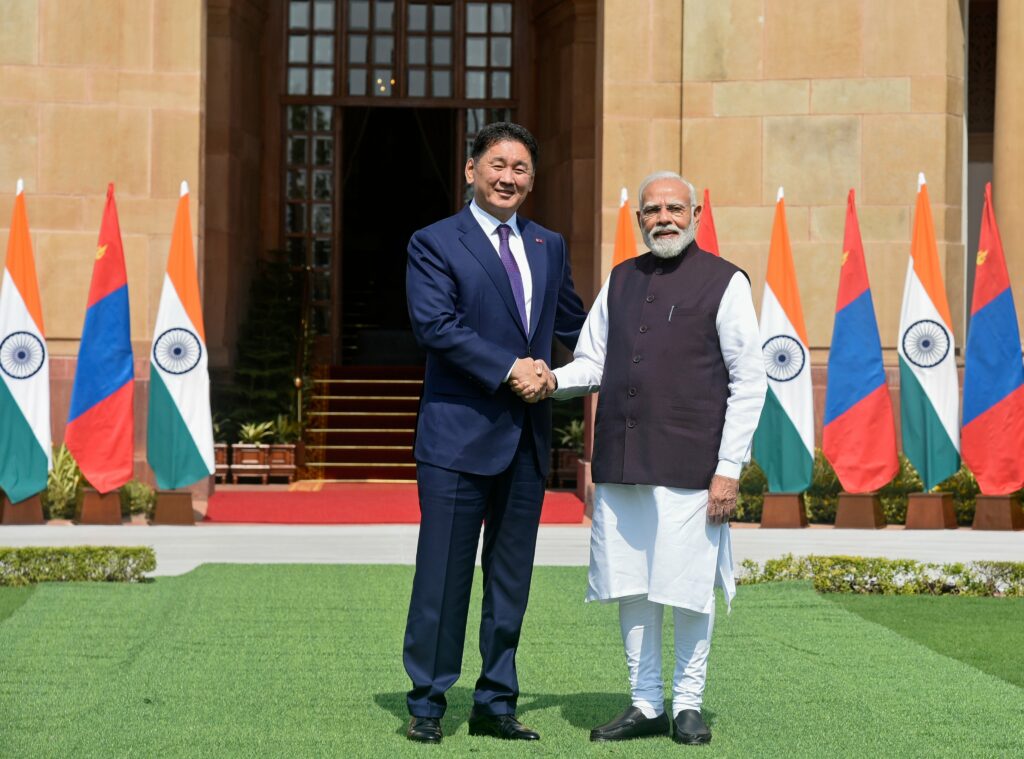
- The 3Ds – Democracy, Dharma and Development Partnership – have emerged as the pillar of the India-Mongolia relationship.
- Both countries have reaffirmed their commitment to stronger cooperation through military exercises like Nomadic Elephant and Khaan Quest.
- Mongolia reiterated support for India’s bid for a permanent seat on the UN Security Council, and for India’s non-permanent seat for 2028–29.
- By investing in defence training, energy infrastructure, and cultural exchange and tourism now, India may lock in goodwill, credibility, and long-term footholds that pay off in decades.
On October 14th 2025, India and Mongolia marked a milestone in their long-lasting relationship, celebrating 70 years of diplomatic ties. Prime Minister Narendra Modi and Mongolian President Khurelsukh Ukhnaa held high-level talks in Delhi, witnessing the signing of multiple MoUs. The Mongolian President’s visit to India highlighted the deepening cooperation between the two countries across multiple sectors.
Historically, the two nations have interacted through the vehicle of Buddhism, which has developed and promoted friendship and spiritual connections. Some historians believe that certain tribes from the Kangra kingdom migrated to Mongolia approximately 4300 years ago. India was among the first countries to establish diplomatic ties with Mongolia in 1955, and the relationship between the two countries has continued to grow to this day.
The 2025 visit marks a milestone as both countries celebrate 70 years of diplomatic ties and a decade of strategic partnership between India and Mongolia. The 3Ds – Democracy, Dharma and Development Partnership – have emerged as the pillar of the India-Mongolia relationship.
Key Agreements and Initiatives
Defence and Security: PM Modi has announced a new capacity-building program for Mongolia’s border security forces. He said that the two countries are close partners and share a commitment to a free, open and Indo-Pacific. Both countries have reaffirmed their commitment to stronger cooperation through military exercises like Nomadic Elephant and Khaan Quest. Meanwhile, India has agreed to provide e-visas free to Mongolian citizens.
Energy and Infrastructure: India has committed support for a $1.7 billion oil refinery project in Mongolia. This initiative will help Mongolia to enhance energy security, and this is Mongolia’s first major refinery and is expected to process 1.5 million metric tons of crude annually and to become operational by 2028. India has also expressed oil and gas exploration opportunities in Mongolia. A joint Indian delegation visited the refinery project site in May 2025 to review progress and reaffirm timelines.
Cultural and Spiritual Bonds: PM Modi has also announced that to further strengthen cultural ties, India will send the sacred relics of Sariputra and Maudgalyayana, the two disciples of the Buddha, to Mongolia, and a Sanskrit teacher will also be sent to the Gandantegchinlen Monastery for the detailed study of the Buddhist texts. The ten agreements signed between both countries were on the cooperation between the Ladakh Autonomous Hills Development Council, Leh and Mongolia’s Arkhangai province.
Diplomatic and global: Mongolia reiterated support for India’s bid for a permanent seat on the UN Security Council, and for India’s non-permanent seat for 2028–29. Multiple framework agreements were signed (on climate, energy, culture, and geology), and India appointed a resident defence attaché in Ulaanbaatar.
Strategic Stakes and Constraints
The current visit is less ceremonial than it appears: India is seeking a foothold in a space where China, Russia, and other powers already carry weight. Geographically, Mongolia sits between those giants; strategically, it offers India an opportunity to expand influence in a region not fully dominated by them. But that also means India must tread strategically, exploring tangible value in trade, security, and technology, rather than relying solely on shared Buddhist heritage or symbolic solidarities.
Yet limitations exist in the relationship. Mongolia’s landlocked geography makes energy and trade projects costly and logistically complex. The oil refinery project, though ambitious, will stretch Indian capital and engineering capacity; delays or cost overruns could invite scepticism at home and criticism in Ulaanbaatar. Moreover, while Mongolia’s leadership supports India’s global claims (e.g. UNSC membership), internal political stability is fragile: earlier in 2025, mass protests over corruption forced the Mongolian Prime Minister to resign. That volatility means agreements inked in Delhi may face headwinds in implementation depending on domestic politics. In essence, for India, the challenge is not signing MoUs but ensuring they don’t remain on paper.
Economically, Mongolia is a small market. The returns from trade and investments will not immediately rival those from India’s larger partners. India must calibrate expectations so that it doesn’t oversell what the partnership can yield in the short term. If India aggressively pushes big infrastructure deals without solid, equitable structuring, accusations of neo-clientelism may surface.
Still, the incremental gains matter. By investing in defence training, energy infrastructure, and cultural exchange and tourism now, India may lock in goodwill, credibility, and long-term footholds that pay off in decades. The 3D framework hints at this: India is not just exporting capital or security cooperation, but signalling a civilisational and normative bond. Whether that endures will depend on discipline, follow-through, and humility in relations.
In conclusion, this state visit is not just a diplomatic high note, but a test of India’s ability to translate vision into capability in a complex region. In the era of geopolitical change, the lasting relationship between India and Mongolia stands as a symbol of strength. The 70 years of diplomacy confirm that shared visions and common values can overcome geographic distance. The visit of 2025 shared a vision for regional peace, prosperity and a stronger strategic partnership for the years ahead.
References:
- https://www.mea.gov.in/bilateral-documents.htm?dtl/40207
- https://www.newsonair.gov.in/india-and-mongolia-sign-key-agreements-to-boost-cooperation-in-culture-energy-and-minerals/
- https://thewire.in/diplomacy/india-mongolia-uranium-cooperation-delhi-backed-oil-refinery-progress
- https://eoimongolia.gov.in/pages/MTY4
- https://en.wikipedia.org/wiki/2025_Mongolian_protests?utm_source=chatgpt.com
Anshu Mishra holds a bachelor’s degree in History from Kolkata University and is currently preparing for the UPSC Civil Services Examination. Her interests include geopolitics, climate change, and national security. Views expressed are the author’s own.
